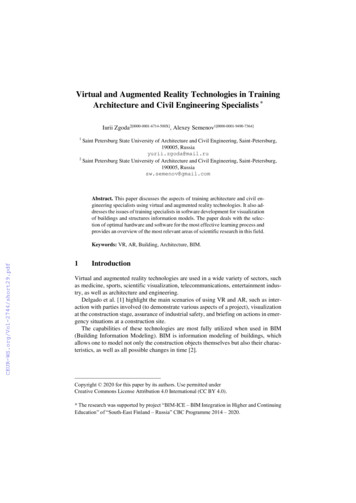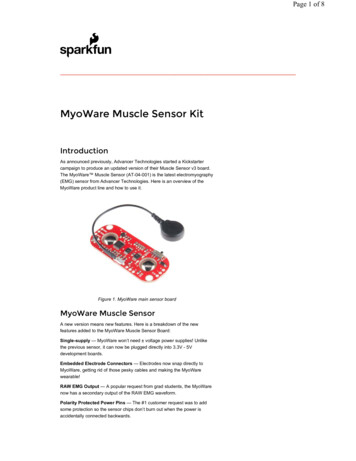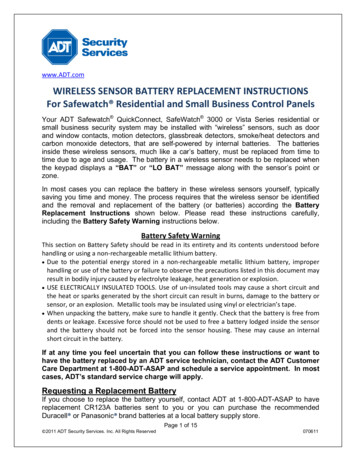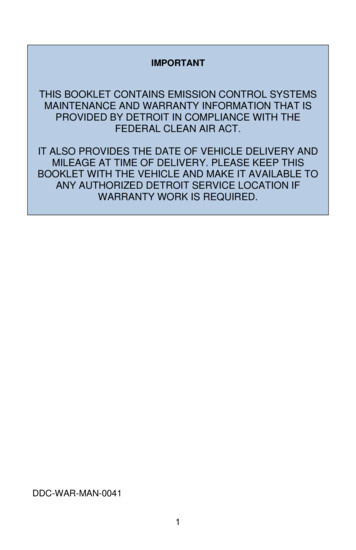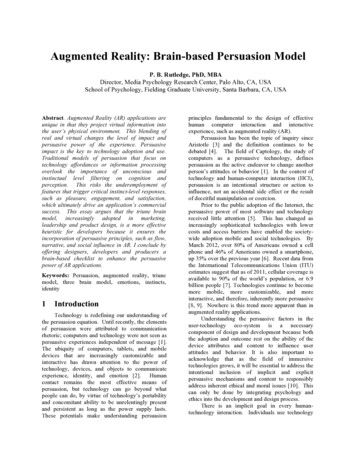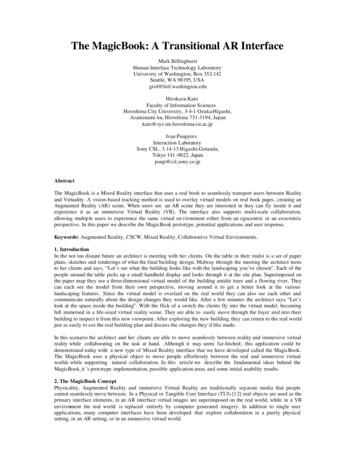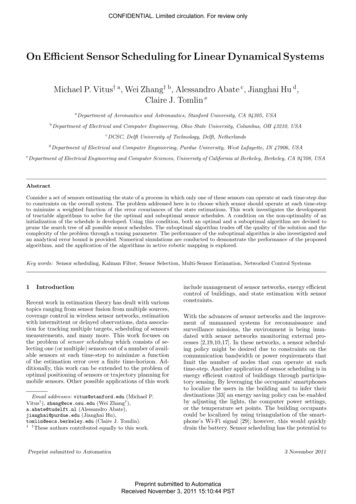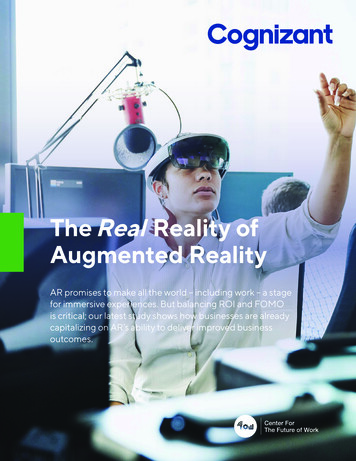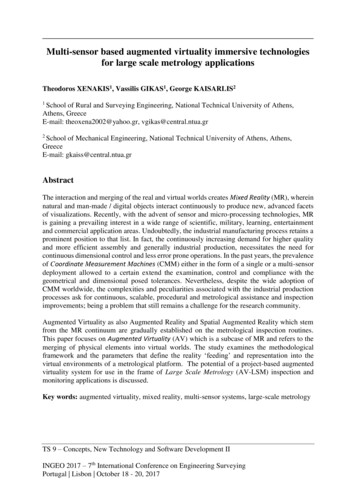
Transcription
Multi-sensor based augmented virtuality immersive technologiesfor large scale metrology applicationsTheodoros XENAKIS1, Vassilis GIKAS1, George KAISARLIS21School of Rural and Surveying Engineering, National Technical University of Athens,Athens, GreeceE-mail: theoxena2002@yahoo.gr, vgikas@central.ntua.gr2School of Mechanical Engineering, National Technical University of Athens, Athens,GreeceE-mail: gkaiss@central.ntua.grAbstractThe interaction and merging of the real and virtual worlds creates Mixed Reality (MR), whereinnatural and man-made / digital objects interact continuously to produce new, advanced facetsof visualizations. Recently, with the advent of sensor and micro-processing technologies, MRis gaining a prevailing interest in a wide range of scientific, military, learning, entertainmentand commercial application areas. Undoubtedly, the industrial manufacturing process retains aprominent position to that list. In fact, the continuously increasing demand for higher qualityand more efficient assembly and generally industrial production, necessitates the need forcontinuous dimensional control and less error prone operations. In the past years, the prevalenceof Coordinate Measurement Machines (CMM) either in the form of a single or a multi-sensordeployment allowed to a certain extend the examination, control and compliance with thegeometrical and dimensional posed tolerances. Nevertheless, despite the wide adoption ofCMM worldwide, the complexities and peculiarities associated with the industrial productionprocesses ask for continuous, scalable, procedural and metrological assistance and inspectionimprovements; being a problem that still remains a challenge for the research community.Augmented Virtuality as also Augmented Reality and Spatial Augmented Reality which stemfrom the MR continuum are gradually established on the metrological inspection routines.This paper focuses on Augmented Virtuality (AV) which is a subcase of MR and refers to themerging of physical elements into virtual worlds. The study examines the methodologicalframework and the parameters that define the reality ‘feeding’ and representation into thevirtual environments of a metrological platform. The potential of a project-based augmentedvirtuality system for use in the frame of Large Scale Metrology (AV-LSM) inspection andmonitoring applications is discussed.Key words: augmented virtuality, mixed reality, multi-sensor systems, large-scale metrologyTS 9 – Concepts, New Technology and Software Development IIINGEO 2017 – 7th International Conference on Engineering SurveyingPortugal Lisbon October 18 - 20, 2017
INGEO 20171INTRODUCTIONRecently, the continuously growing of scientific research on immersive technologies and MixedReality (MR) systems have fructified their benefits in large scale metrology (LSM) andmanufacturing applications. MR is the combination of the real and virtual environments thatleads to a novel, hybrid space, in which both extremes complement each other to denature theirstatus to a more informative and effective result. Augmented reality/virtuality (AR/AV) systemsare evident in many applications, such as in personal assistance and awareness systems, innavigation and touring, in combat and simulation, medicine, entertainment and media,manufacturing assembly and maintenance, collaborative training, education, robot technology,etc. (van Krevelen, D.W.F. et al 2010). In effect, the increasing need for higher quality and lesscostly industrial products emerged the necessity for real time insight across the completespectrum of the manufacturing process stages (i.e., in-process inspection, assembly, guidance,monitoring and positioning) and has paved the way for the combined use of MR technologies.LSM, a subset of which refers to industrial geodesy, employs geodetic and photogrammetrictechniques for the accurate measurement, dimensioning and representation of manufacturedobjects, ranging from a few meters to several 10s of meters (Kyle, S.A. et al 2001). In LSMoperations, object tracking and measurement accuracy form critical quality indicators for anyMR system. Also, the applicability and effectiveness of a QC/QA procedure associated withthe industrial fixtures and part assembling, it depends on the accompanying sensor performance.Portable Coordinate Measurement Machines (CMM) and/or other tracking devices that usedmainly indoors such as Ultra-WideBand (UWB), Radio Frequency IDentification (RFID),ultrasound, inertial and optical vision systems facilitate augmentation between a simulated 3Denvironment (designed or reconstructed) with ‘reality’ inside an advanced metrology platform(Kaisarlis, G. et al. 2015). In sensu stricto, these systems can be categorized to the class of AVsystems.This paper examines AV immersive technologies in regard to LSM applications; hereafternamed AV-LSM systems. The theoretical background, the usage and innovations of MRsystems as they applied to the manufacturing domain are discussed in Section Two. SectionThree focuses on AV systems for LSM applications while their system architecture andinfluence variables are also examined. A case study originating from the naval engineeringindustry is presented. Conclusions are summarized in Section Four.2MIXED REALITY IN LARGE SCALE METROLOGY AND THEMANUFACTURING INDUSTRYIt has been already over twenty years since Paul Milgram, P. et al. (1994) presented virtualcontinuum and MR space which lies between the real and virtual-digital extremes. In thisdomain, both edges are combined and displayed simultaneously. The percentage between realand virtual content that becomes evident to the end user classifies the final system either asAugment Reality (AR) or Augmented Virtuality (AV).In AV systems, reality prevails to the total virtual content and vice-versa on AR systems. Thereality – virtuality spectrum can be enriched with other three classes, such as amplified reality,mediated reality and virtualized reality (Schnabel, M.A. et al. 2007).Portugal Lisbon October 18 - 20, 2017
Xenakis, T. et al.: Multi-Sensor Based Augmented Virtuality AV and AR share the same system architectural principles with the crucial difference of theaugmented subject (i.e., virtual world with reality or reality with virtual objects respectively).Bimber, O. and Raskar, R (2005) presented the basic elements of an augmented reality systemshown in Figure 1.UserApplicationInteraction Devices andTechniquesTracking and RegistrationPresentationAuthoringDisplay TechnologyRenderingFig.1 Augmented reality building blocks (Bimber, O. and Raskar, R. 2005)Recently, the evolution in the domain of immersive virtual technologies, together with thetremendous improvements in accuracy, precision and robustness on measurement sensors, inmicro-processing and computer science have triggered the intrusion of MR systems in thebroader LSM and manufacturing industry. Potential benefits can be found on rapid prototyping,plant layout design, assembly line optimization, production process and control as well asmaintenance (Caricato, P. et al. 2014). On their extended review paper, Nee, A.Y.C. et al.(2012) discuss the past and current practices while focusing on future trends on research anddevelopment of AR systems. Among others, their work presents a variety of MR, but mainlyAR studies on topics such as collaborative design, robot path training, assisted maintenancesystems, plant layout and operation planning, assembly design and CNC simulation. GonzaloFranco, M. et al. (2017) studied a MR metaphor for collaborative training in aerospace. Thestatistical significance equivalences with conventional training revealed the promisingperformance in the context of collaborative training. In the aerospace domain, Lapointe, J.F. etal. (2001) examined the development of virtualized reality systems for space tele-manipulationand improvements on control systems. Doil, F. et al. (2003) developed a web-based AR-systemfor improving the effectiveness of factory planning layout and final visualization on shop floor.Segovia, D. et al. (2015) examined the relationship between AR and Computer Aided Quality(CAQ) software (Q-Management software) for the accessibility to the performance informationand general view of the production line. Additionally, they analyzed the benefits that evolvedfrom the exploitation of MR systems based on statistical process control and six sigmamethodology inside the automotive industry for the prevention of costly flaws. Zhou, J. et al.(2012) examine a spatial augmented system for the informative assistance of spot weldinginspection on a physical work-cell. Novak-Maricincin, J. et al. (2013) highlighted the new eraof virtual manufacturing, in which all stages from decision to control anddimensioning/designing and shop floor activities are enhanced by computer aided systems andimmersive technologies. Lastly, MR systems can contribute to a disaster management andpreventative measures of facilities and infrastructures from natural and technological disastersas pointed out in Wursthorn, S et al.(2004).A more immersive trend can be observed to the early design stages of LSM hardware andsoftware. Modern tracking sensors have abilities for on-the-fly depiction of position andorientation data in conjunction with CAD files, digital terrain models and other surveyinformation by using the capabilities of the on-board software (e.g. Leica Captivate).Furthermore, the majority of metrological software has already started to embody elements
INGEO 2017from immersive technologies. Today, their core design allows the vivid presentation of complex3D CAD models. The virtual content is augmented with real data from measurement sensorsby transforming the platform to an AV system. For instance, Spatial Analyzer , PC-DMIS,3DReshaper, Metrolog XG, PolyWorks InspectorTM, Geomagic Control XTM, PowerInspectare members of an indicative list of metrological software with the aforementioned technicalcharacteristics; however, the exhaustive reference on metrology vendors and products is beyondthe scope of this paper. Interactive devices (e.g. Geomagic TouchTM Haptic Device) as wellas total mixed reality systems have also started to appear in LSM market (e.g. Faro VisualInspect AR, Trimble SketchUp Viewer).Despite the great potential and the increasing use of MR technologies in the industrial and LSMapplications, the number of limitations and technological challenges still to resolve are evident.Contrary to other application areas, such as in gaming and entertainment, manufacturing MRsystems are still facing the need for accurate and direct tracking (e.g. tolerances of mm or submm are required), the (auto)calibration and valid superposition of augmented information, theminimization of static and dynamic errors during registration, elimination of latency issues dueto tracking and/or image rendering, the fast compression and loading of datasets and modelsand the provision of an immersive interfacing technology (Nee, A.Y.C. et al. 2012; Holloway,R.L., 1997; Wursthorn, S. et al. 2004). Furthermore, portability, ergonomy and acceptabilityaspects of MR systems are other issues that should be taken under consideration.3LARGE SCALE METROLOGY AUGMENTED VIRTUALITYSYSTEMSToday, modern commercial and/or customized metrology software platforms are functioningas Augmented Virtuality (AV) systems. The virtual environment which is realized by thegraphical windows is augmented with input from the real word through feeding from a singleor multi-sensor configuration. The virtual content may take the form of 3D models, design data,GD&T annotations prepared on a computer-aided design software or even reconstructedsurfaces of real counterparts (Holloway, 1997). Computer core and graphic processing unit(CPU/GPU) selected display devices and render configurations (tessellation facets, multipliervalue) adjust the fidelity and final representation of the virtual environment (e.g., native CADfiles, measurements, ‘avatar’ reflectors/markers/instruments, meshes). Problems withocclusion, shadow – casting, as well as system lagging and mis-registration need to beapproached on the graphic engines (Bimber, O. and Raskar, R. 2005). Otherwise, the user willbe frustrated and it will be difficult the comparison between virtual and real. On AV-LSMsystems, the metaphor of presence mainly includes monitor based displays with multi-scopingimaging and exocentric viewing (without excluding more immersive sforms(e.g. polar coordinates, point fixes, point clouds, digital photos) are being registered, filtered,processed and presented as downstream information such as, spatial relationships, vectors, 2.5Dmaps and reporting to the display peripheral data in comparison to a CAD entity.Each examined LSM case study has different questioned objective targets. The scalability onthe types and values of the inspection tolerances lead to the selection of the proper coordinatemeasurement sensors. Also, a number of operational parameters and quality features, includingworking range, accuracy, measurement frequency, proximity limitations, etc. define sensorPortugal Lisbon October 18 - 20, 2017
Xenakis, T. et al.: Multi-Sensor Based Augmented Virtuality characteristics depending on specific measurement operation (Muelaner, J. et al., 2008). Laserbased spherical coordinate measurement systems, iGPS, articulated measurement arms, fixedcoordinate measurement machines, optical scanners, photogrammetric systems are typicalsensor accessories employed for the identification, assurance and acceptance of the geometricand dimensional tolerances.Because an AV-LSM system represents a projection of reality superimposed on apredominantly virtual environment (Pouke, M. 2015), the degree of reality in the mixed worldis defined by the technical ability and robustness of the selected sensors and applicationtechnique. Table 1 provides a summary classification of the critical factors that define the finaloutcome in an AV-LSM system (Kalantar-Zadeh, K. 2013;Paffenholz, J.A. et al, 2016).Table 1: Variables that define the degree of reality in an AV-LSM systemSensorSensor 1Sensor 2Environment ooooooAccuracyPrecisionRepeatabilityWorking RangeResolution/Sampling RateSignal-to-Noise RatioDriftSynchronization (TemporalReferencing)Registration (SpatialReferencing)Data FusionSensitivityHysteresisLatency/Collection andResponse TimeCalibration / SystematicError Sensor nooooooooTemperature/Humidity/PressureRefractive IndexHeat currentsThermal inhomogeneous zonesAttenuationObject of InterestMaterial on the sameobject and on thesurrounding areaReflectivityEstablishment ofcontrol/check pointsDifferentialmovementsMetrology Platform Host – computer delayMathematical and stochastic model of measurementsProper modeling of all variables that contribute to the finalresultsProcessing AlgorithmsReliabilityProcessing and Graphic EngineDisplay and Render DelayIn the remaining of this section, the benefits resulting from an AV system on the manufacturingprocess are highlighted based on the personal experience of the first of the authors. The casestudy stems from a quality inspection of an erected ship. The main measurement objective wasthe real-time inspection of the ship hull (CAD file in *.igs format) against the actual constructedhull surface. In this case the AV system was realized via a Leica TDRA6000 industrial totalstation with relevant Break Resistant Reflectors (BRR). The metrology platform employed bythe Hexagon Spatial Analyzer. The software runs on a HP EliteBook mobile workstation. Thegeodetic sensor is communicating with the instrument interface via a network TCP/IP protocolas shown in Figure 2.
INGEO 2017After the initial geolocation to the object coordinate system (registration), the CAD filewas imported to the metrology platform. Observations and 3D model had a commongeoreference and therefore, the deviations from the nominal surfaces could directly bedisplayed and documented on multiple graphic views. A heads-up display presented the resultedmeasured points. The general pipeline of the specific case study is presented in Figure 3.TCP/IPSENSORLeica TDRA 6000 industrial totalstationAngle Accuracy 0.5 EDM Performance (1.5’’ BRR) 0.5 mmEDM Performance (Reflective Tape) 1.0 mmEDM Performance (Non Contact) 2.0 mm3D Point Reproducibility 0.2 mmDual CompensatorsHARDWAREHP EliteBook Mobile WorkstationCore Processing Intel Core i7– 3630 QM CPU @ 2.40 GHz/2.40GHzRAM 20 GBInternal Hard Disk 500 GB (SolidState Drive)Operating System Windows 10 ProMETROLOGYPROCESSINGPLATFORMHexagon SpatialAnalyzerTotal StationPlatform UserInterfaceGRAPHIC CARDNVIDIA Quadro K1000MDISPLAY DEVICELaptop 15X10.1 inches displayCAD.igs formatFig.2: System architectureDetermination ofdatum and detailpointsReal timecomparison ofdesign and as-buildgeometryEstablishment andmeasurement ofcontrol networkDefinition of properspatial relationshipsand reportingoptionDefinition of objectcoordinate system(OCS)Configuration ofuser interfaceRigidtransformation ofmeasurement toOCSREALITYSECTORImport of nominalCAD geometry (.igs)VIRTUALITYSECTORFig.3 Case study of an AV-LSM workflowPortugal Lisbon October 18 - 20, 2017
Xenakis, T. et al.: Multi-Sensor Based Augmented Virtuality The evaluation of the observation / processing set-up in the aforementioned case study as wellas the outcome from similar applications reveal the advantages and great potential of AV-LSMsystems in the quality inspection process. By exploiting the wide spectrum of analytical andreporting functionalities of the platform, the end user is capable to identify and successfullyresolve artifacts and, therefore, meet tight QC product line schedules. User friendly interfacesand heads-up displays attribute an informative role and improve the critical analysis.Furthermore, geo-referencing tools that integrate information obtained from multi-sensorsystems and the use of CAD model representations enable the seamlessly interaction ofheterogeneous data that could further enhance the decision making process.4CONCLUSIONSThe wide use of AV-LSM and MR systems are close to the establishment of a status-quo onthe sector of mass assembly lines and the manufacturing industry. In this regard, the academicand research interest focuses on the many challenging issues still present in most industrialapplications, such as requirements concerning accuracy, proper synchronization and directresponse of all members of the system into an immersive virtual environment. State-of-the artof metrology platforms seems to adopt the aforementioned trend and to be turned to more andmore immersive perspective regarding their visualization, processing and interactionfunctionalities.REFERENCESNee, A.Y.C. – Ong, S.K. – Chryssolouris, G. – Mourtzis, D. 2012. Augmented RealityApplications in Design and Manufacturing, In CIRP Annals – ManufacturingTechnology, Vol.61, 2012, pp. 657-679.Gonzalez-Franco, M. – Pizarro, R. – Cermeron, J. – Li, K. – Thorn, J., Hutabarat, W., Tiwari,A., Bermell-Garcia, P. 2017. Immersive Mixed Reality for Manufacturing Training, InFrontiers in Robotics and AI, ResearchGate, Vol.4 (3), 2017, pp.9.Milgram, P. –Kishino, F. 1994. A Taxonomy of Mixed Reality Visual Displays, InIEICETransactions on Information and Systems, Vol.77(12), 1994, pp. 1321–1329.Pouke, M. 2015. Augmented Virtuality: Transforming Real Human Activity into VirtualEnvironments, In Academic Dissertation of the Doctoral Training Committee, Universityof Oulu, Finland,ISSN 1796-2226, 2015, pp. 109.Doil, F. – Schreiber, W. – Alt, T. – Patron, W. 2003. Augmented Reality for ManufacturingPlanning, In Eurographics Workshop on Virtual Environments, Zurich, Switzerland:EGVE, 2003, pp. 71 – 76.Segovia, D. – Mendoza, M. – Mendoza, E. – Gonzalez, E. 2015. Augmented Reality as a Toolfor Production and Quality Monitoring, In VARE 2015, International Conference onVirtual and Augmented Reality in Education, Elsevier Vol.75, 2015, pp. 291 – 300.Novak-Marcincin, J. – Novakova-Marcincinova, L. 2013. Application of Augmented RealityTechnologies in Virtual Engineering, In Academic Journal of ManufacturingEngineering, Vol.11, 2013, pp. 4
INGEO 2017Caricato, P. – Colizzi, L. – Gnoni, M.G. – Grieco, A. – Guerrieri, A. – Lanzilotto, A. 2014.Augmented Reality Applications in Manufacturing: a Multi-Criteria Decision Model forPerformance Analysis, In 19th World Congress International Federation of AutomaticControl, Cape Town, South Africa: IFAC, 2014, 6 pp.Holloway, R. L. 1997. Registration Error Analysis for Augmented Reality, In JournalPresence: Teleoperators and Virtual Environments, MIT Press, Vol.6 Issue 4, 1997, pp.413-432Muelaner, J. – Maropoulos P. G. 2008. Large Scale Metrology in Aerospace Assembly, In 5thInternational Conference on Digital Enterprise Technology, Nantes, France: DET, 2008,10 pp.Kalantar-zadeh, K. Sensors: An Introductory Course, In Springer Science Business Media,ISBN 978-1-4614-5052-8, New York, 2013, pp. 11-27.Paffenholz, J. A. - Bureick, J. – Diener, D. – Link, J. 2016. Synchronization Aspects of Sensorand Data Fusion in a Research Multi-Sensor System, In 5th International Conference onMachine Control & Guidance, Vichy, France: MCG, 2016, 20 pp.Bimber, O. – Raskar, R. 2005. Spatial Augmented Reality: Merging Real and Virtual Worlds,In A K Peters/CRC Press, ISBN 1-56881-230-2, Wellesley, Massachusetts, 2005, pp. 1 12Schnabel, M. A. – Wang, X. – Seichter, H. – Kvan, T. 2007. From Virtuality to Reality andBack, In International Association of Societies of Design Research, Hong Kong: IASDR,2007, 15 pp.Wursthorn, S. – Coelho, A.H. – Staub, G. 2004. Applications for Mixed Reality, In XXth ISPRSCongress, Istanbul, Turkey, 6 pp.Van krevelen, D.W.F. – Poelman, R. 2010. A Survey of Augmented Reality Technologies,Applications and Limitations, In International Journal of Virtual Reality, IJVR, 2010,Vol.9 (2), pp. 1-20.Kaisarlis, G. - Gikas V. - Xenakis T. - Stathas D. - Provatidis C. (2015) “Combined Use ofTotal Station and Articulated Arm Coordinate Measuring Machine on Large ScaleMetrology Applications”, 1XXI IMEKO World Congress, Prague, Aug. 30–Sept. 2Lapointe, J.F. – Boulanger, P. 2001. Live Virtual Reality System for the Control and Monitoringof Space Operations, In 6thInternational Symposium on Artificial Intelligence andRobotics & Automation in Space, St-Huber, Quebec, Canada: i-SAIRAS, 2001, 7 pp.Kyle, S.A. – Robson, S. – Chapman, D. P. – Cross, A. – Iliffe, J. C. – Oldfield, S. 2001,Understanding Large Scale Metrology, In National Measurement Conference, Harrogate:NMC, 2001, 5 pp.Zhou,J. – Lee,I. – Thomas, B. – Menassa, R. – Farrant, A. – Sansome, A. 2012, In-Situ Supportfor Automotive Manufacturing Using Spatial Augmented Reality, In International Journalof Virtual Reality, IJVR, 2012, Vol.11(1), pp. 31 – 41.Portugal Lisbon October 18 - 20, 2017
approached on the graphic engines (Bimber, O. and Raskar, R. 2005). Otherwise, the user will be frustrated and it will be difficult the comparison between virtual and real. On AV-LSM systems, the metaphor of presence mainly includes monitor based displays with multi-scoping imaging and exocentric viewing (without excluding more immersive trends).

